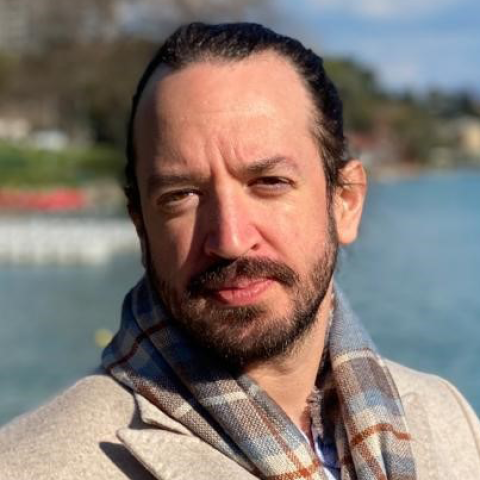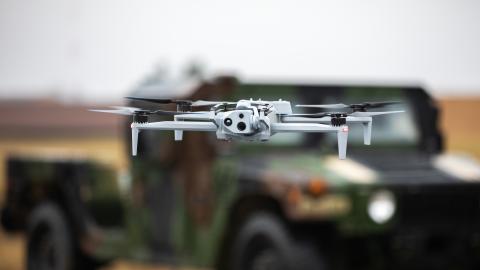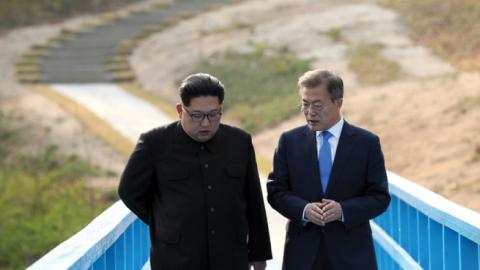TABLE OF CONTENTS
Introduction: Peaceful Change on the Korean Peninsula? - Patrick M. Cronin
I. Reversing Kim Jong-un’s Nuclear Program
* Reducing the Nuclear Threat: A US View - Bruce Klinger
* Calculating Pyongyang's Next Steps and Coordinating a Response: A South Korean View - Jina Kim
II. Dealing with North Korea’s Chronic Underdevelopment
* Sustainable Economic Development in North Korea - Young-kwan Yoon
* Economic Engagement with North Korea Post-denucluearization - Troy Stangarone
III. Preserving an Alliance in Flux
* Preserving the Rok-US Alliance - In-bum Chun
* The Rok-US Alliance: One American’s Perspective Now and for the Future - David S. Maxwell
IV. China’s Long Shadow Over the Peninsula
* China-North Korea Ties: Back to “Lips and Teeth”? - Seong-hyon Lee
INTRODUCTION
The possibility of peaceful change on the Korean Peninsula appears less realistic today than it did throughout 2018 and 2019. Instead of a rapid breakthrough to curb nuclear dangers and cement inter-Korean peace, the peninsula seems to be reverting back to its cold war norm. But that hardly precludes further change, for good or ill, as the post-World War II historical record might suggest. In 1945, Korea was simultaneously liberated from Japanese control and divided at the 38th parallel.1 Not long after the 1948 founding of the Republic of Korea (ROK) in the south and the Democratic People’s Republic of Korea (DPRK) in the north, the peninsula experienced the first of three major transformations.
The initial and most costly transformation began on June 25, 1950, when North Korea’s Kim Il-sung launched a military invasion of South Korea.2 Three years of fighting resulted in more than three million people dead.3 The 1953 armistice, which endures to this day, put a halt to the conventional war, but also reinforced the peninsula’s sharp divide by creating a demilitarized zone (DMZ) that is 160 miles long and 2.5 miles wide.4
If a hot war leading to a cold war marked the first transformation of the Korean Peninsula in the past seventy years, a poor dictatorship metamorphosing into a rich democracy highlighted the second big change. Although this second transformation is limited to the southern half of the peninsula, the rise of South Korea, a global middle power, is significant and enduring. South Korea’s economy began its ascent after the Korean War. In 1987, after turbulent protests by a nationwide democracy movement, it introduced democratic elections and moved closer to “joining the ranks of advanced, democratic countries of the world.”5 By 1995, the “Miracle on the Han” had shot up to become the world’s eleventh-largest economy, a position it still holds to this day.6 With more than 51 million people and a GDP in excess of $1.7 trillion, the ROK has more than twice the population of its northern neighbor and some fifty times the DPRK’s $32 billion GDP. Thus, even though the first postwar transformation of the peninsula perpetuates a harsh division between the two Koreas, South Korea’s global rise and success represent a second, far more beneficial transformation.
North Korea’s relentless pursuit of weapons of mass destruction (WMD), and especially its dedicated program to build nuclear-armed missiles, represents a third transformation of the Korean Peninsula.7 This third major development, however, threatens the success of the second and could create a nuclear war that would make the death and destruction of the first seem minor by comparison. Pyongyang has emerged as a de facto nuclear state, and its appetite for WMD appears undimmed by years of sanctions and diplomatic overtures. Kim Jong-un’s steady buildup of a nuclear arsenal, now estimated to include as many as thirty nuclear warheads and fissile material for up to sixty weapons, makes him a danger throughout Northeast Asia and, indeed, all the way to the United States.8 Despite the restraint of North Korea’s technologically advanced democratic neighbors, South Korea and Japan, the impoverished dictatorship clings to nuclear weapons for its survival, for coercion, and yet, possibly, for bargaining leverage.
Hence, the third transformation, the nuclearization of North Korea, is the preface to a fourth transformation, which could be catastrophic or alternatively, might well usher in a soft landing for North Korea and a peaceful transformation of the entire Korean Peninsula. Positive change depends on the Kim regime’s decisions, because the leaders in both Seoul and Washington remain open to serious negotiation. While the 1990s produced a US-North Korea Agreed Framework, and the early 2000s led to six-party talks, previous efforts at achieving both peace and denuclearization were short-lived. The passing of Kim Jong-il in December 2011 appeared to provide a possible break from decades of hostility. However, by March 2012, Kim Jong-un was conducting long-range rocket launches that scuttled an early attempt at rapprochement with the third-generation Kim family leadership. US and South Korean relations with North Korea deteriorated in 2016 when the UN Security Council agreed on the harshest sanctions to date to penalize Kim for his nuclear and long-range missile tests.
The May 2017 election of South Korean president Moon Jae-in, heir to previous attempts at inter-Korean peace, followed by the election of President Donald Trump in November, accelerated two distinctive approaches to negotiating with North Korea’s Kim. Moon tried every incentive for dialogue that he could imagine, and Trump dialed up a “maximum pressure” approach that culminated in “fire and fury” threats during the latter half of 2017. However, after Kim tested two Hwasong-14 intercontinental ballistic missiles (ICBMs) in July, his third nuclear device in September (which Pyongyang proclaimed to be a hydrogen bomb), and one Hwasong-15 ICBM in November, he declared success and pivoted to diplomacy.9 Though Kim had been keeping President Moon at arm’s length, he declared in his New Year’s message on January 1, 2018, that he wanted to “improve the frozen inter-Korean relations” through dialogue with South Korea, even though North Korea would also “mass-produce nuclear warheads and ballistic missiles.”10 South Korea’s inclusion of the North in the 2018 Winter Olympics in Pyeongchang broke the ice, catalyzing a flurry of summits with Moon, Trump, and China’s Xi Jinping.11 By mid-2018, and the first-ever meeting between the leaders of the United States and North Korea, peace and a possible roadmap toward denuclearization seemed more than plausible.12
However, after more than two years of experimental diplomacy, the initial progress has been halted and seemingly overturned. An unsuccessful Kim-Trump summit in Hanoi in February 2019 revealed how far apart Pyongyang and Washington remained over the scope and price of denuclearization, and no amount of confidence-building measures between North and South could compensate Kim Jong-un for what he treasures most: namely, major investment and sanctions relief, guaranteed security, and equal status with the big powers. Kim’s suspension of previous moratoria on nuclear and long-range missile tests; his threat in January 2020 to produce a new strategic weapon; and his new, harder-line foreign minister all augur poorly for a diplomatic breakthrough. Nonetheless, hardline posturing in 2017 preceded the diplomatic overture that followed shortly after that, and Kim and Trump and Moon may find a way to stitch together accords that put diplomacy back on track. Perhaps cooperation over a shared interest in preventing the highly contagious coronavirus that started in Wuhan, China, will open a new opportunity for engaging North Korea. Then again, Pyongyang remains suspicious of outside assistance, and another North Korean provocation could derail negotiations for the remainder of this year and beyond.
So why bother thinking about the stable transformation of the Korean Peninsula when it seems apparent that the now thirty-seven-year-old Kim is doubling down on nuclear weapons for his survival? The sudden strike on Iranian general Qasem Soleimani might encourage Kim to continue a nuclear buildup in an attempt to forestall possible regime change directed by South Korea’s major ally, the United States. Or perhaps the lesson for Kim is to get smarter about diplomacy and accept a series of small steps in which meaningful nuclear and weapons programs would be put under an international inspections regime, in exchange for commensurate security and economic benefits. Will a fourth transformation begin to take hold? Will it be violent or peaceful? If South Korea and the United States, in particular, are to attempt a peaceful transformation, how will they approach the fundamental issues of the North’s nuclear weapons and economic development, the ROK-US alliance, and relations with China?
These questions are at the heart of this volume, which was conceived in the midst of the historic meeting in Singapore between President Trump and Kim Jong-un. The aim was not to get bogged down in the up-and-down details of diplomacy but instead, to ask leading American and South Korean scholars to consider how to advance inter-Korean peace and denuclearization, while preserving the ROK-US alliance and managing relations with China. US-China strategic rivalry is transcending the North Korean problem, but overlapping interests in avoiding war and the proliferation of nuclear weapons might yet bring Washington and Beijing closer together. Could peace replace the 1953 armistice, and could that peace be replaced without disrupting the macro-stability that has endured, more or less, ever since? Also, could North Korea be transformed from a pariah outlier and outlaw state to part of the comity of nations, with normal diplomatic ties with all of its neighbors? Answering the four issues—about nuclear weapons, North Korean development, the bilateral alliance, and relations with China—will go a long way toward addressing the prospects for the peaceful transformation of the Korean Peninsula.
Reversing Kim’s Nuclear Arms Program
A peaceful transformation of the Korean Peninsula would require that North Korea be convinced to abandon its nuclear weapons or, at a minimum, to submit to a rigorous, long-term program of denuclearization in exchange for economic development. Though Pyongyang proclaimed apparent willingness to commence a process of denuclearization in 2018, it backtracked throughout 2019, and 2020 began with scant signs of optimism. Thus far, official assertions from Seoul and Washington that Kim Jong-un has agreed to relinquish his nuclear weapons have proven facile. Given Pyongyang’s unwillingness to take any substantial step toward surrendering a major part of its nuclear weapons and their means of delivery, it is difficult to imagine Kim taking a bold step to advance peace and a wholly different relationship with South Korea and the United States. North Korea’s self-declared moratoria on nuclear tests and long-range missile tests—the most positive steps Kim has taken since launching a diplomatic charm offensive in January 2018—were reversed at the beginning of 2020, when he declared that he would no longer be bound by his earlier pledge.13 Indeed, he simultaneously threatened some “new strategic weapon,” perhaps suggesting a move to deploy a full-scale ICBM.14 Coming on the heels of an active year of missile testing in 2019, Kim’s latest threats cannot be taken lightly.
Perhaps denuclearization never had any realistic prospects, given the vital role Pyongyang’s nuclear weapons appear to play in providing the Kim family regime with insurance against outside military intervention. Regime survival is a stronger driving force than economic development, and recent diplomatic setbacks seem to reinforce this pessimistic analysis. Bruce Klingner, in his essay on the US perspective on nuclear weapons, sees great continuity in how the Kim family regimes have approached nuclear weapons. Klingner, who has been watching North Korea’s military developments for decades, first at the Central Intelligence Agency and, more recently, at the Heritage Foundation, dismisses those who were euphoric over summit meetings, noting that “Pyongyang rejects the core premise” of abandoning its nuclear weapons. He contends that diplomacy has failed repeatedly, sanctions and sanctions relief have fallen short, security guarantees are inadequate, and economic aid has not worked. While he can imagine some sort of limited arms control agreement, such as a freeze or cap on nuclear production in exchange for sanctions relief and de facto recognition of North Korea as a nuclear-weapon state, he intimates that would not advance US national security interests. “Unfortunately,” he concludes, “there is greater reason for pessimism than optimism regarding a diplomatic solution to the North Korean nuclear program.” Nonetheless, he constructively enumerates policy recommendations that could guide future engagement, including insistence on a detailed roadmap for denuclearization; stringent verification measures; a continuation of sanctions and pressure; upholding human rights; making economic aid conditional; building confidence and reducing miscalculation; and resuming military exercises to ensure a ready and capable alliance. In sum, reflecting the general view from Washington, “accept there simply may be no set of inducements to ensure North Korean abandonment of its nuclear weapons.”
Klingner’s compelling line of argument would seem to leave little room for optimism. Yet Jina Kim, a North Korea expert based at Seoul’s leading defense think tank, the Korea Institute of Defense Analyses (KIDA), frames the challenge of reducing the nuclear threat in broader terms. She asks salient questions about North Korea’s behavior, from its addiction to nuclear weapons to its penchant for provocation, before turning to the policy question of what South Korea and the United States should do to attenuate the nuclear threat on the peninsula. In drilling down into Kim Jong-un’s security anxieties, Dr. Kim suggests that these may lie at the root of the problem. She discusses three scenarios.
First, a risk-averse Kim Jong-un may be interested in cooperative threat reduction. Although various confidence-building measures would not necessarily lead to denuclearization anytime soon, they could provide a degree of strategic stability and encourage a process of peaceful transformation. Many South Koreans appear to support this kind of step-by-step arms control, though it might also seem to confirm the notion that denuclearization is not a realistic near-term objective.
Second, protracted negotiations may allow a more risk-acceptant North Korea to acquire more lethal military capabilities while gradually chipping away at the sanctions regime designed to contain it. This line of argument is more compatible with Klingner’s diagnosis of North Korea’s intentions, and the growing chorus of those recommending a return to “maximum pressure,” or at least tightening sanctions and bolstering alliance military capabilities.
Third, North Korea may be simply biding its time until it can finally break out with a decisive new means for dealing with South Korea and the United States. David Maxwell amplifies this line of argument, noting it comports with North Korea’s long-term strategy of unifying the peninsula on its terms. Many national security professionals in South Korea and the United States would be wary of ever giving Pyongyang sufficient opportunity to think that such a daring breakout scenario would be possible or effective.
Dr. Jina Kim makes a powerful argument for a cooperative threat-reduction program, which could provide incentives for diplomacy; reduce the risk of inadvertent conflict; increase transparency; internationalize the problem of North Korea’s nuclear weapons and the solution of economic development; and minimize the chances of cheating by Pyongyang. Furthermore, Dr. Kim notes that cooperative threat reduction is a tool that has proven itself in US work with post-Soviet states. What is more, this approach provides a natural way for South Korea to step up its involvement and contribute to putting a lid on all of North Korea’s WMD programs.
Meanwhile, Dr. Kim adds that cooperative threat reduction will also require that other, related challenges be addressed. If a gradual roadmap can be realized for walking back the dangers of North Korea’s nuclear program while addressing the Kim regime’s legitimate fears, other policies—for enhancing export controls and the effective enforcement of sanctions—will be required to ensure extended deterrence amid a changing security environment.
Indeed, the North Korean problem cannot be reduced to nuclear weapons alone. As democratic elections in South Korea and the United States lead to changes in government, policy preferences can shift. Future administrations in Seoul and Washington may be less indulgent of North Korea’s recalcitrance. But there can be no denying the focus of President Moon Jae-in and his administration on trying to write a new chapter in North-South relations. If an arms control or cooperative threat-reduction process could buy time, then North Korean economic development might increase Kim Jong-un’s stake in a peaceful peninsula, although not necessarily a fully transformed one. Likewise, the Trump administration has kept the door for diplomacy wide open for Kim Jong-un, despite a tougher line from Pyongyang since late 2019 and early 2020. After all, North Korea has not, as of this writing, crossed any redlines. Kim may well be conducting hardline posturing—including the sacking of one foreign minister and his replacement with a more militaristic one—in the hope that he will be offered more concessions for taking very small steps that could be considered a prelude to denuclearization. For the Kim regime, there are two main reasons to pursue this course of action: one is that it will not have to abandon nuclear weapons anytime soon; the second is that it could begin to unlock the sanctions arrayed against North Korea. From the vantage point of Kim Jong-un, perhaps the immediate question is how to accelerate economic development without seriously impairing his WMD programs. This leads to a discussion of North Korea’s development.
Dealing with North Korea’s Chronic Underdevelopment
Young-kwan Yoon and Troy Stangarone take complementary approaches to their subject of North Korea’s economic development. Both believe that the basic challenge is how to introduce market liberalization into North Korea while understanding that the economic dimension of policy is inextricably intertwined with security issues. What is also clear, however, is that looking at relations with North Korea through an economic lens yields a different picture of the challenge than focusing only on the national security or nuclear dimension.
For former South Korean foreign minister Yoon, North Korea’s economic future centers on successful marketization. North Korea’s planned—or, more precisely, “planless”—economy needs to introduce powerful market forces, despite the risk this will pose to the Kim family regime. Although Kim’s grandfather, Kim Il-sung, failed to travel down the road of serious economic reform, his father, Kim Jong-il, was forced to introduce some reforms in the wake of a disastrous famine.15 Yoon sees a glimmer of hope that Kim Jong-un will eventually introduce greater marketization. This stems from the fact that in recent years, North Korea has allowed informal and unofficial markets, giving rise to a growing class of financial entrepreneurs (known as donju, literally “masters of money”).16 While some of Kim’s early trial programs in agriculture and other sectors have stalled or regressed, tolerance for small markets has become prevalent inside North Korea.
Yoon argues, however, that to push Kim Jong-un toward bold reform, South Korea, the United States, and other countries will have to offer significant inducement in the form of infrastructure investment. If Kim can create a high—even double-digit—rate of economic growth, Dr. Yoon believes, the Kim family will be able to cushion itself from potential domestic strife and retain sufficient regime security. But according to Yoon, without such a dramatic inducement, Pyongyang will simply attempt more cosmetic changes designed to buy off elites.
As outside democracies, especially the United States and South Korea, consider possible major investments, they will need a clear blueprint for delivering economic assistance within North Korea. They will also need a way to calibrate assistance and sanctions or sanctions relief to the pace of peace and denuclearization talks. This is the principal message of Troy Stangarone, who enumerates myriad issues for US and South Korean officials to consider and debate to enhance the chances of success and minimize the risks of making North Korea richer before it is less militarized. Ultimately, North Korea needs to redefine the role of the state in its economy by addressing the need for labor market reform, privatization of state-owned enterprises, trade liberalization, financial sector reform (including reconciling market prices and prices set by the state), and other structural changes. Stangarone recommends leveraging allies and partners and international institutions to offer timely, high-quality infrastructure to compete with China’s massive capacity for exporting its programs.
If North Korea suffers from a disarmament dilemma, the United States and South Korea face a different security dilemma: how to promote a brighter future for North Korea through development without inadvertently strengthening Pyongyang’s WMD and military forces. And with the nuclear problem so difficult to fix and the economic challenge of modernizing impoverished North Korea pending, the question about how to preserve an alliance in flux is both salient and urgent. The ROK-US alliance is especially important at a time when Seoul and Washington are contending not just with North Korea strategy, but with burden-sharing, trade, and relations with China, Japan, Iran, and others.
Preserving an Alliance in Flux
As the ROK-US alliance remains in flux, China’s growing power continues to cast a large shadow over the two Koreas.17 But as diplomacy with North Korea remains stagnant and Pyongyang’s WMD programs carry on, escalating US-China competition poses an acute challenge to South Korea: Washington remains Seoul’s main security guarantor, but Beijing is an essential economic partner. And as the United States presses South Korea to shoulder greater burdens for the alliance, while simultaneously nudging it to look at China’s emerging power, the Moon administration is grappling with how to preserve the ROK-US alliance without jeopardizing its other interests.
Retired Lt. Gen. In-bum Chun is one of the most decorated and pro-US officers to have served in the upper ranks of the ROK Army. Yet his message is complex: politics are shifting in Korea, and the United States cannot afford to lose its vaunted position as a trusted and reliable ally, which would surely happen if it pressed too hard to extract more burden-sharing, rather than focusing mostly on overlapping common interests. Chun’s message is neither easy to read nor a simple nationalistic pushback on US demands; it is, instead, a clarion call, from someone who knows both countries well, not to squander this alliance—which is of vital geostrategic importance to both countries—on secondary issues.18 North Korea has a special pull on South Korea, and Washington must understand this. South Korea has a special concern about Japan, and Washington must also appreciate this. And, in a future showdown between China and the United States, South Korea will side with the winner, and Washington must also grasp this reality.
David Maxwell brings an equally impressive record to US-ROK alliance issues; he has been at the heart of both alliance contingency planning and questions about the future of the North Korean regime. He offers a clear message for US alliance managers and national security planners: steady as she goes, the stakes for US interests are tremendous, and the United States will have an easier time with all other policies if it gets the ROK-US relationship right. Indeed, despite South Korea’s relative success, it still faces an existential threat from North Korea, and the ROK-US alliance is the main bulwark that guarantees peace and preserves stability. Maxwell details the Kim family regime’s long history of ideological and political warfare, which continues today despite high-level meetings and occasionally euphoric statements that peace and denuclearization are at hand. Like Gen. Chun, David Maxwell is deeply concerned about the stresses on alliance managers as they seek to navigate around disputes over burden-sharing, operational control of forces in wartime, and the future roles, capabilities, and missions of the bilateral alliance. The alliance, both Chun and Maxwell note, is a vital interest for both countries because it preserves stability on the Korean Peninsula and brings long-term stability to Northeast Asia. How to solicit China’s help with managing North Korea, while keeping an eye on the future of Northeast Asia as a whole, is the main subject of the last pair of essays in this volume.
China’s Long Shadow over the Peninsula
Patricia Kim and Seong-hyon Lee offer two incisive analytical essays concerning China’s role and relations with the United States and South Korea. Both authors are acutely aware that the three countries have different interests and different “end states” in mind when contemplating the stable transformation of the Korean Peninsula. Dr. Kim argues that the United States wants to retain strong linkages to the peninsula and Northeast Asia, but despite diplomatic overtures to Kim Jong-un, Washington appears to lack a clear vision for how North Korea would fold into a free and open Indo-Pacific region. China also wishes to retain stability and sees relations with North Korea as necessary, but it hopes that Pyongyang’s economic development could be a model for regional integration. And South Korea wants a balance between an alliance with the United States and peaceful relations with China, all while seeking gradually improving relations between the two Koreas.
The three governments’ different approaches complicate diplomacy, regardless of whether negotiations with North Korea are at an impasse or are making substantive progress. If North Korean denuclearization stalls, China may well turn its attention to pressuring South Korea to distance itself from the United States. Conversely, should diplomacy with North Korea show new promise, then the ROK-US governments will need to strengthen their consensus on a vision for a mutually desired end state. Dr. Kim underscores the need for South Korea and the United States to hammer out a common vision based on shared principles, and for Washington to support Seoul against Beijing’s pressure tactics. A strong alliance is one of the best means for securing the peaceful transformation of the Korean Peninsula, and the allies must not delude themselves into thinking that robust institutionalized dialogue is the same thing as sharing a common set of goals.
Seong-hyon Lee’s essay illuminates China’s role in the peninsula in several ways. First, Dr. Lee observes the return of a tight relationship between Beijing and Pyongyang. Just as a growing US-China competition is leading to talk of decoupling, China and North Korea are once again acting like allies. Xi Jinping’s June 2019 visit to Pyongyang has effectively normalized relations with Kim Jong-un. China and North Korea, Dr. Lee argues, are moving back in the direction of a “lips and teeth” relationship, a reference to Mao Zedong’s phrase describing a deeply intertwined bilateral relationship.19 However, there is considerable distrust between China and North Korea, and it is still too soon to know how deep their alignment will go. Of more immediate concern to officials trying to find a peaceful diplomatic pathway forward with North Korea, China is proposing its own solution for dealing with the Kim family regime. Beijing takes full credit for the notion of a “double freeze” (of DPRK nuclear and ICBM tests and US-ROK military exercises), which had defined the major diplomatic moves adopted in 2018–19. But what does this portend for 2020 and beyond?
In part, this “Chinese solution” means that for the Chinese leadership, North Korea is secondary to US policy. Thus, if or as US-China relations deteriorate, the United States should expect China to resist “solving” the North Korean nuclear problem. China will help restrain the level of North Korean provocations (and thereby encourage Kim to pursue diplomacy). Although there is good reason to question how much China has “helped” the United States by pressuring North Korea, Beijing does share an interest in keeping North Korea stable. Of course, that means it will be difficult to return to “maximum pressure,” with China fully on board with harsh sanctions, in the absence of reckless North Korean actions. Diplomatic efforts with North Korea could muddle through for the foreseeable future, even without tangible progress. That means, provided no new provocation shifts the debate, all governments can defer the need for a diplomatic bargain until after the November 2020 US election. Even so, there are cogent arguments for the Trump administration to address weaknesses in the sanctions regime. Moreover, with China and Russia taking the lead on a proposal to ease sanctions as an inducement for talks, North Korea could be missing a window of opportunity to strike a modest bargain that would achieve some economic development.20 Still, if Pyongyang can acquire more nuclear weapons and, at the same time, erode and circumvent sanctions, there is little incentive to strike a deal with President Trump until it is clear whether he is re-elected.
Whether a peaceful transformation happens soon or in the distant future, it remains preferable to either a hot war or an indefinite cold war that could turn hot in the time it takes to launch a missile. Whether diplomacy with Chairman Kim can produce a breakthrough of sustained, gradual peace, or new provocations and hardline positions spell the return of greater hostility, Presidents Moon and Trump have not been wrong to test the Kim regime’s intentions. While it would be foolhardy to accept a bad deal, claims of progress and fears of a catastrophe have both been exaggerated at times. As the authors of this volume would agree, a serious, complex set of prescriptions will be needed to keep the peace in Northeast Asia, without giving up the search for a peninsula in which both sides are nuclear free and prosperous.















